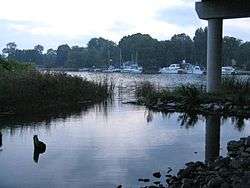Mnjikaning Fish Weirs
| Mnjikaning Fish Weirs | |
|---|---|
 | |
| Nearest city | Orillia, Ontario |
| Coordinates | 44°36′15″N 79°22′11″W / 44.60417°N 79.36972°WCoordinates: 44°36′15″N 79°22′11″W / 44.60417°N 79.36972°W |
| Original use | Harvesting fish |
| Official name: Mnjikaning Fish Weirs National Historic Site of Canada | |
| Designated | 12 June 1982 |
The Mnjikaning Fish Weirs are one of the oldest human developments in Canada. These fishing weirs were built by the first nations people well before recorded history, dating to about 3,300 BCE during the Archaic period in North America,[1] according to carbon dating done on some of the wooden remnants. The weirs were built in the narrows between Lake Couchiching and Lake Simcoe, now known as Atherley Narrows,[1] over which Ontario Highway 12 passes today. They were preserved by the water and layers of protective silt.
The weirs were built as fences using local wood species, including eastern white cedar, sugar maple, and white birch for the stakes.[2] The weirs were used to trap the various fish species swimming through them. The early fishermen wove brush and vegetation among the weirs to make net-like fencing where the fish were guided to be speared, netted or kept for later use, particularly for consumption during the winter.[1]
The weirs – historically called ouentaronk (Huron) and tkaronto (Mohawk) – are believed to have provided the City of Toronto with its name, following a series of copy errors.[3][4] They were in use for about 5,000 years, until about the early 1700s.[5] Samuel de Champlain recorded their existence on September 1, 1615, when he passed the weirs with the Huron en route to the battle with the Iroquois on the south east side of Lake Ontario.
The Mnjikaning Fish Weirs was officially recognized as a National Historic Site of Canada on 12 June 1982.[6] It is managed by the Rama First Nation, who created the Mnjikaning Fish Fence Circle to protect and promote the site.[7]
See also
Notes
- 1 2 3 Munson & Jamieson 2013, p. 121.
- ↑ Munson & Jamieson 2013, p. 121, figure 7.6.
- ↑ City of Toronto.
- ↑ Natural Resources Canada.
- ↑ Bernick 2013, p. 76.
- ↑ Parks Canada.
- ↑ Chippewas of Rama First Nation, Mnjikaning Fish Weirs, at current day, Atherley Narrows.
References
- Bernick, Kathryn (2013). Menotti, Francesco; O'Sullivan, Aidan, eds. The Oxford Handbook of Wetland Archaeology. Oxford Handbooks in Archaeology. Oxford University Press. ISBN 9780199573493.
- Munson, Marit K.; Jamieson, Susan M., eds. (2013). Before Ontario: The Archaeology of a Province. McGill-Queen's native and northern series. 72. McGill-Queen's Press - MQUP. ISBN 9780773589193.
- "About us". Chippewas of Rama First Nation. Retrieved 8 May 2015.
- "Mnjikaning Fish Weirs National Historic Site of Canada". Parks Canada. Retrieved 8 May 2015.
- "Origin of the name of Toronto". City of Toronto. Retrieved 23 April 2017.
- "The real story of how Toronto got its name | Earth Sciences". Geonames.nrcan.gc.ca. September 18, 2007. Archived from the original on December 9, 2011. Retrieved 23 April 2017. ref=CITEREFNatural_Resources_Canada }}
External links
- Mnjikaning Fish Weirs National Historic Site of Canada at HistoricPlaces.ca (Parks Canada)